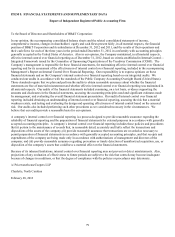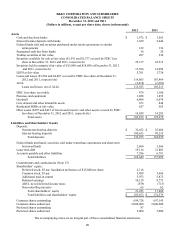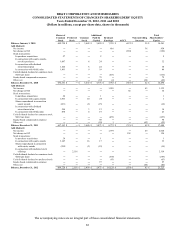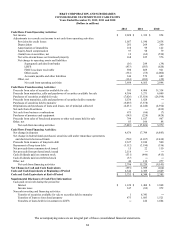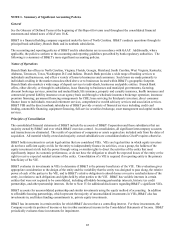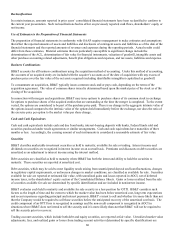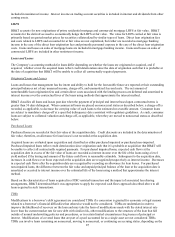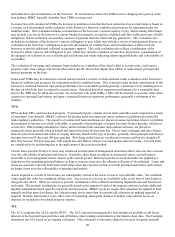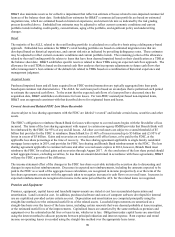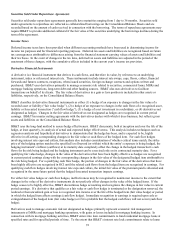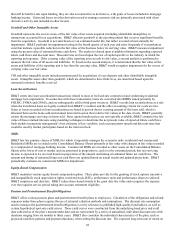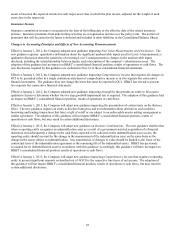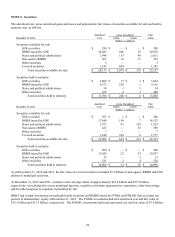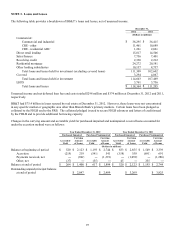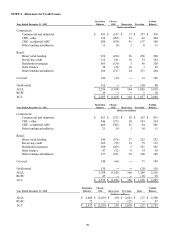BB&T 2012 Annual Report Download - page 111
Download and view the complete annual report
Please find page 111 of the 2012 BB&T annual report below. You can navigate through the pages in the report by either clicking on the pages listed below, or by using the keyword search tool below to find specific information within the annual report.
89
estimates, including the amounts and timing of cash flows expected to be received on impaired loans. Those estimates are
susceptible to significant change. Changes to the ACL are made by charges to the provision for credit losses, which is
reflected in the Consolidated Statements of Income. Loans or lease balances deemed to be uncollectible are charged off
against the ALLL. Recoveries of amounts previously charged off are credited to the ALLL. The methodology used to
determine the RUFC is inherently similar to that used to determine the collectively evaluated component of the ALLL,
adjusted for factors specific to binding commitments, including the probability of funding and exposure at default. While
management uses the best information available to establish the ACL, future adjustments may be necessary if economic
conditions differ substantially from the assumptions used in computing the allowance or, if required by regulators, based
upon information available to them at the time of their examinations.
Accounting standards require the presentation of certain disclosure information at the portfolio segment level, which
represents the level at which an entity develops and documents a systematic methodology to determine its ACL. BB&T
concluded that its loan and lease portfolio comprises three portfolio segments; commercial, retail and covered. The
commercial portfolio segment includes CRE, commercial and industrial and other loans originated by certain other lending
subsidiaries, and was identified based on the risk-based approach used to estimate the ALLL for the vast majority of these
loans. The retail portfolio segment includes direct retail lending, revolving credit, mortgage, sales finance and other loans
originated by certain retail-oriented subsidiaries, and was identified based on the delinquency-based approach used to
estimate the allowance for these loans. The covered portfolio segment was identified based on the expected cash flows
approach used to estimate the allowance related to loans acquired subsequent to December 31, 2008.
A portion of BB&T’ s ALLL is not allocated to any specific category of loans. This unallocated portion of the allowance
reflects management’ s best estimate of the elements of imprecision and estimation risk inherent in the calculation of the
overall allowance. Due to the subjectivity involved in determining the overall allowance, including the unallocated portion,
the portion considered unallocated may fluctuate from period to period based on management’ s evaluation of the factors
affecting the assumptions used in calculating the allowance, including historical loss experience, current economic
conditions, industry or borrower concentrations and the status of merged institutions.
The entire amount of the ACL is available to absorb losses on any loan category or lending-related commitment.
The following provides a description of BB&T’ s accounting policies and methodologies related to each of its portfolio
segments:
Commercial
The vast majority of loans in the commercial lending portfolio are assigned risk grades based on an assessment of conditions
that affect the borrower’ s ability to meet contractual obligations under the loan agreement. This process includes reviewing
borrowers’ financial information, historical payment experience, credit documentation, public information, and other
information specific to each borrower. Risk grades are reviewed on an annual basis for all credit relationships with total
credit exposure of $1 million or more, or at any point management becomes aware of information affecting the borrowers’
ability to fulfill their obligations. For commercial clients with total credit exposure less than $1 million, BB&T has
developed an automated loan review system to identify and proactively manage accounts with a higher risk of loss. The
“score” produced by this automated system is updated monthly.
On a quarterly basis, BB&T reviews all commercial lending relationships with outstanding debt of $5 million or more that
have been classified as substandard or doubtful. While this review is largely focused on the borrower’ s ability to repay the
loan, BB&T also considers the capacity and willingness of a loan’ s guarantors to support the debt service on the loan as a
secondary source of repayment. When a guarantor exhibits the documented capacity and willingness to support the loan,
BB&T may consider extending the loan maturity and/or temporarily deferring principal payments if the ultimate collection of
both principal and interest is not in question. In these cases, BB&T may not deem the loan to be impaired due to the
documented capacity and willingness of the guarantor to repay the loan. Loans are considered impaired when the borrower
(or guarantor in certain circumstances) does not have the cash flow capacity or willingness to service the debt according to
contractual terms, or it does not appear reasonable to assume that the borrower will continue to pay according to the
contractual agreement. BB&T establishes a specific reserve for each loan that has been deemed impaired based on the
criteria outlined above. The amount of the reserve is based on the present value of expected cash flows discounted at the
loan’ s effective interest rate, and/or the value of collateral. BB&T has also established a review process related to TDRs and
other impaired loans that are in commercial lending relationships with outstanding debt of less than $5 million at the balance
sheet date. In connection with this process, BB&T establishes reserves related to these loans that are calculated using an
expected cash flow approach. These discounted cash flow analyses incorporate adjustments to future cash flows that reflect
management’ s best estimate of the default risk related to TDRs based on a combination of historical experience and
management judgment.


